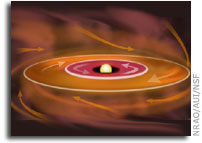
(Spaceref.com) "This is the first time anyone has seen anything like this, and it means that the process of forming planets from such disks is more complex than we previously expected," said Anthony Remijan, of the National Radio Astronomy Observatory, who with his colleague Jan M. Hollis, of the NASA Goddard Space Flight Center, used the National Science Foundation's Very Large Array radio telescope to make the discovery.
"The solar system that likely will be formed around this star will include planets orbiting in different directions, unlike our own solar system in which all the planets orbit the Sun in the same direction," Hollis explained.
This star is located about 500 light years away from Earth and is located in the direction of the Ophiuchus constellation. Star systems normally acquire "planet building material" which is generally taken from a prestellar cloud. Apparently this young system has somehow captured two.

(Spaceref.com) "We think this system may have gotten material from two clouds instead of one, and the two were rotating in opposite directions," Remijan said.
There is sufficient material to form planets from both parts of the disk, he added. The object is in a large, star-forming region where chaotic motions and eddies in the gas and dust result in smaller cloudlets that can rotate in different directions.
In the solar system that probably will form around this young star, the innermost planets will orbit in one direction and the outer planets will orbit in the opposite direction.
Sightings like these generally occur within the disks of galaxies, although this is the first time something like this has been observed an emerging system. If we are ever fortunate enough to visit this system (after the worlds cool) it will make an interesting place to call home.
Want more space geek news? Then subscribe below via email, RSS or twitter for free updates! Prefer another service? How about via RSS or follow Colony Worlds on Twitter!




![ColonyWorlds[at]Gmail[dot]com](http://img.photobucket.com/albums/v438/hiddennook/ColonyWorlds.png)







No comments:
Post a Comment
You can either visit the stars or watch them from afar.
But if you choose the former, you'll definitely get a better view.
~Darnell Clayton, 2007
Note: You do not need a Blogger account in order to comment, but you do need to solve the universal puzzle below.